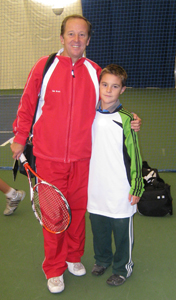Returning: Long-range sniper or Ninja Assassin
 Sunday, November 20, 2011 at 11:15AM
Sunday, November 20, 2011 at 11:15AM  CAtennis
CAtennis 
If you find yourself missing your targets in the return, ask yourself: "am I a long-range sniper or a Ninja Assassin?" Sometimes, I find that a student is missing too many returns off totally playable serves. The standard question often is: where were you aiming? The standard answer is (pointing at a particular spot on the court): there or there.
For the most part when returning, the fact is that the server controls the point (at least in the later stages of your development). This means that even if your forehand is a weapon, so is his serve. Using a hyperbole, your forehand may be a bazooka but it's usually trumped by the A-bomb posed by the serve. Therefore, when missing the serve, remember to throttle back your ego and play smart.
Instead of aiming for targets on the other side of the net, aim for imaginary targets ON TOP OF THE NET. Instead of being like a long range-sniper, get up close and personal with your intended target. In other words, aim for something closer to you. Know that if you hit the target on top of the net, the ball will follow its intended trajectory and find its ultimate target on the other side of the court. To put it another way, if you had a gun, would you rather shoot a target that's 15 feet away or a target that's 50 feet away?! If you've ever fired a weapon, you know that the bullet will drop due to gravity and wind resistance. The further the target is, the more adjustments you have to make. Furthermore, you only have a split second to make these adjustments since your "bullet" (I.e., ball) is a moving target itself making it all the more imperative that you bring the target closer.
So learn from the Ninja Assassin and bring your target closer for the definite kill. To practice this, thread broomsticks or PVC pipes through the net and aim for them initially. Keep a mental check of where the ball landed in comparison with your close target. When you're in a match situation, you will have developed a feel for how you need to strike a certain ball in order for it to reach its ultimate spot.




